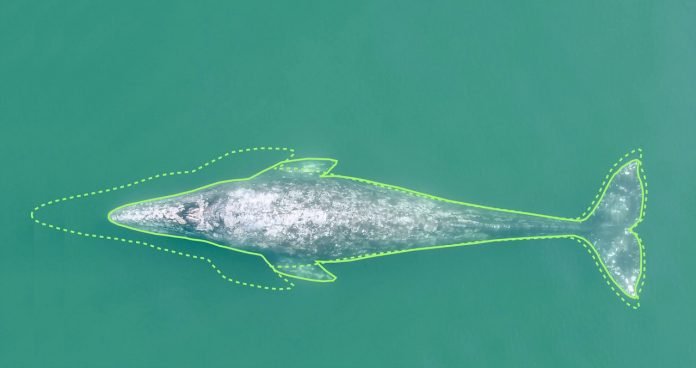
Gray whales that feed along the Pacific Northwest coast have become 13% shorter over the past 20-30 years, according to a new study from Oregon State University (OSU).
The research reveals that these whales, which spend their summers in the shallow waters off the Pacific Northwest, have been shrinking since around the year 2000.
This size reduction could have serious consequences for their health and ability to reproduce, and it raises concerns about the overall health of the ocean ecosystem they rely on.
K.C. Bierlich, an assistant professor at OSU’s Marine Mammal Institute and co-author of the study, noted the potential implications.
“This could be an early warning sign that the abundance of this population is starting to decline, or is not healthy,” Bierlich said.
“Whales are considered ecosystem sentinels, so if the whale population isn’t doing well, that might say a lot about the environment itself.”
The study, published in the journal Global Change Biology, focused on the Pacific Coast Feeding Group (PCFG), a smaller group of about 200 gray whales within the larger Eastern North Pacific (ENP) population, which numbers around 14,500.
Unlike most gray whales that spend much of the year in the Arctic, the PCFG whales stay closer to shore along the Oregon coast, feeding in shallower and warmer waters.
Recent studies from OSU have shown that the PCFG whales are not only smaller but also in worse overall condition compared to their ENP counterparts.
The current study confirms that these whales have been getting smaller over the past few decades.
Researchers at OSU’s Marine Mammal Institute’s Geospatial Ecology of Marine Megafauna (GEMM) Lab have been studying the PCFG whales since 2016.
Using drones to measure their size, they analyzed images from 2016-2022 of 130 individual whales. They found that a gray whale born in 2020 is expected to reach an adult length 1.65 meters (about 5 feet, 5 inches) shorter than one born before 2000.
For PCFG gray whales, which typically grow to be 38-41 feet long, this represents a loss of over 13% of their total length.
Enrico Pirotta, the lead author of the study and a researcher at the University of St. Andrews in Scotland, explained the significance of this size reduction. “In general, size is critical for animals,” Pirotta said.
“It affects their behavior, physiology, and life history, and has cascading effects for the animals and the community they’re part of.”
Smaller whale calves may struggle to survive when they become independent, and smaller adults may have difficulties reproducing successfully.
Bierlich pointed out that smaller body size and lower energy reserves could make these whales less resilient to injuries from boat strikes and fishing gear entanglement.
The study also examined how ocean conditions affect food availability for gray whales. Researchers tracked cycles of “upwelling” and “relaxation” in the ocean, which move nutrients from deeper waters to the surface, supporting the growth of plankton and other tiny organisms that gray whales eat.
A balance between upwelling and relaxation is crucial for producing enough prey to support the large size of gray whales.
Changes in this balance have coincided with the decline in whale size, Pirotta said. While the study didn’t specifically look at how climate change affects these patterns, it’s known that climate change is altering wind patterns and water temperatures in the Northeast Pacific, which could impact upwelling and relaxation cycles.
With the PCFG gray whales shrinking, researchers are now investigating the environmental factors driving these changes. “We’re heading into our ninth field season studying this PCFG subgroup,” Bierlich said. “This is a powerful dataset that allows us to detect changes in body condition each year, so now we’re examining the environmental drivers of those changes.”
The study’s co-authors include Lisa Hildebrand, Clara Bird, and Alejandro Ajó from OSU, and Leslie New from Ursinus College in Pennsylvania. This research underscores the importance of understanding and protecting our marine ecosystems, as changes in whale populations can reflect broader environmental shifts.



